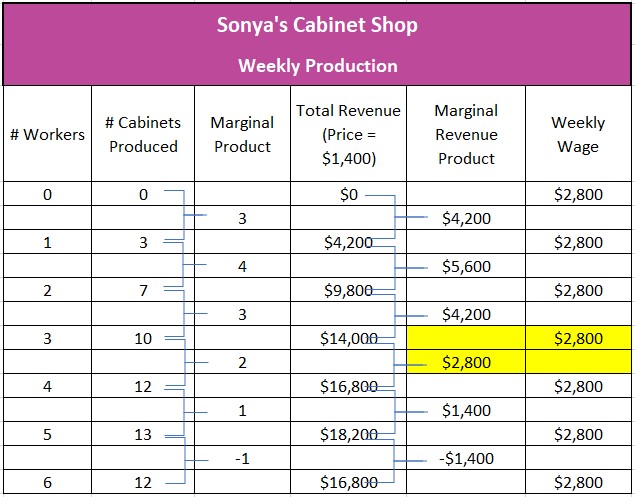An input’s marginal revenue product equals the additional revenue generated by one added unit of the input.
How do businesses decide whether to add an employee or invest in additional equipment? If an employee generates more revenue than their wages, it makes sense to hire that employee. (This statement assumes wages include all costs associated with the employee.) Similarly, if a piece of equipment increases output to the extent that the additional revenues cover the cost of the equipment, a business should purchase it. Businesses calculate an input’s marginal revenue product (MRP) to determine the optimal amount of a given input to use. The input should be acquired as long as an input’s MRP exceeds its cost.
Suppose Sonya just opened a small cabinet shop. Initially, she works by herself and builds three cabinets a week. However, her construction time is limited because she also needs to work with customers and handle administrative tasks. She decides to hire additional workers who can specialize in construction. How many workers should Sonya hire? Sonya can answer this question by calculating the MRP for each added worker and comparing their MRPs to their weekly wages. Her analysis is shown in the table below. Assume her cabinets sell for $1,400 each, and she pays her workers $2,800 weekly. These figures are held constant while only the number of workers is changed.

Sonya believes another employee would increase production from three cabinets to seven cabinets. The marginal product, or the increase in production, would be four cabinets. Since her cabinets retail for $1,400 each, her first hire (second employee, including herself) would increase her revenues by $5,600 (4 x $1,400), as seen in the marginal revenue product column. Her third employee would generate $4,200 in additional revenue. Additional revenue would continue to accrue until the fifth worker when Sonya’s marginal revenue product would equal $1,400. Since the fifth worker would produce less revenue than his wage, Sonya would be ill-advised to hire him.
Notice that Sonya’s marginal revenue product determines her demand for labor. In fact, an input's marginal revenue product curve is a company’s demand curve for the input because it tells a company’s management how much of a given input they should employ at a given price.
Marginal Analysis—How Decisions Are Made
Output and Profit Maximization
Capital and Consumer Goods—HowThey Influence Productivity
Factors of Production—The Required Inputs of Every Business